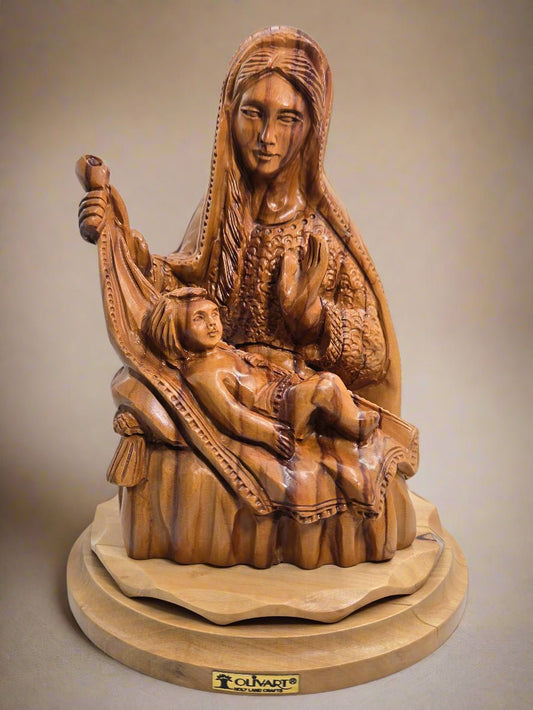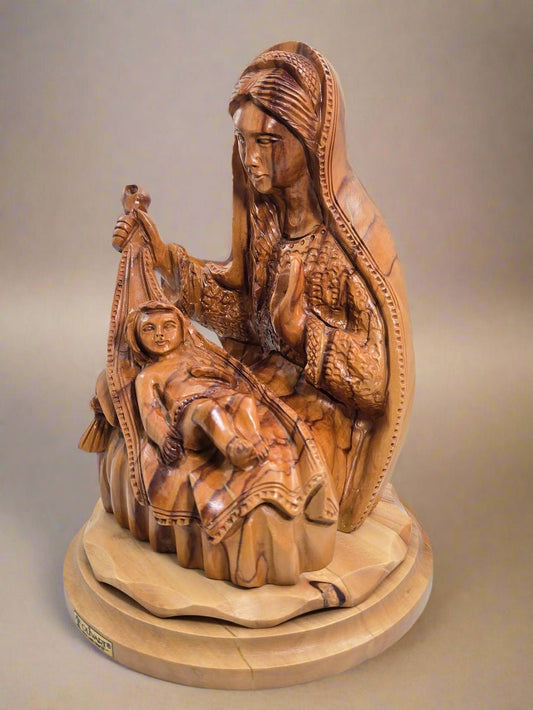
The Via Dolorosa and the 14 Stations of the Cross
Introduction: Walking the Path of Sorrow
The Via Dolorosa, Latin for the "Way of Suffering," is a hallowed and historic route that winds through the Old City of Jerusalem. For centuries, Christian pilgrims have walked this path, which is the traditionally venerated route through Jerusalem's Old City that many Christians believe retraces Jesus' path to Golgotha. The route followed today was formalized in the modern era, and scholars continue to debate its precise historical course [1].
This sacred path, approximately 600 meters (about 1,970 ft) long, is marked by 14 Stations of the Cross, each commemorating a specific event in the final hours of Jesus's life [2]. The Stations of the Cross serve as a powerful devotional practice, allowing the faithful to meditate on the Passion of Christ and its profound spiritual meaning.
This blog post will guide you through the Via Dolorosa and the 14 Stations of the Cross, exploring the historical context, spiritual significance, and meaning of each station. We will delve into the traditional understanding of these events, drawing from centuries of Christian devotion and reflection, while clearly distinguishing between events recorded in Scripture and those that developed through devotional tradition.
Historicity of the Route
Note on Historical Development: The devotion to the Stations predates the modern waymarks, but the current sequence and start point crystallized centuries after the events they commemorate. Many historians place the Roman Praetorium at Herod's Palace near today's Jaffa Gate (not the Antonia Fortress), which would alter the opening segment of the path. The traditional route serves as a framework for spiritual reflection rather than a precise historical reconstruction [3].
The 14 Stations of the Cross: A Detailed Journey
The devotion of the Stations of the Cross is a spiritual pilgrimage that allows us to walk alongside Jesus in his final hours. Each station offers a moment for reflection and prayer, a chance to enter into the mystery of Christ's suffering and sacrifice. It should be noted that some communities also use "Scriptural Stations" introduced by St. John Paul II in 1991, which draw only on explicit Gospel passages, and some traditions include a 15th Station celebrating the Resurrection [4].
1. Jesus Condemned
Biblical Foundation: This station is based on the Gospel accounts of Jesus's trial before Pontius Pilate (Matthew 27:11-26, Mark 15:1-15, Luke 23:13-25, John 18:28-19:16).
Meaning and Reflection: The first station marks the moment when Pontius Pilate, the Roman governor, condemns Jesus to death. Although Pilate states he finds no fault, he ultimately condemns Jesus under pressure from the crowd and some local leaders. This station calls us to reflect on the nature of justice, the weight of public opinion, and the courage it takes to stand for what is right, even when it is unpopular. It is a moment to contemplate the injustice of the world and the silent suffering of the innocent.
2. Jesus Flogged, Given His Cross
Biblical Foundation: The Gospels record that Jesus was scourged and given his cross to carry (Matthew 27:26, Mark 15:15, John 19:1, 19:17).
Meaning and Reflection: After his condemnation, Jesus endures the brutal punishment of flogging and is then given the heavy wooden cross that he must carry to the place of his crucifixion. This station symbolizes the acceptance of suffering and the burden of our sins. As St. John Henry Newman reflected in his Catholic meditation, "Our sins cost Him this humiliation" [5]. It is a powerful reminder that our own failings have consequences and that Christ, in his infinite love, chose to bear the weight of our transgressions.
3. Jesus Falls the First Time
Traditional Foundation: According to tradition, Jesus falls for the first time under the weight of the cross. This event is not explicitly recorded in the canonical Gospels but has been part of devotional practice for centuries.
Meaning and Reflection: Weakened by the scourging and the weight of the cross, Jesus falls for the first time. This station represents the overwhelming burden of sin and the physical and emotional exhaustion that Jesus endured. It is a moment to consider our own weaknesses and failings, and to find strength in the knowledge that even in our darkest moments, Christ understands our struggles.
4. Jesus Meets His Mother
Traditional Foundation: According to tradition, Jesus meets his mother Mary along the Via Dolorosa. While the Gospels record Mary's presence at the crucifixion (John 19:25-27), this specific encounter during the journey is part of devotional tradition.
Meaning and Reflection: Along the Via Dolorosa, Jesus meets his mother, Mary. Their eyes meet in a moment of shared sorrow and love. This station highlights the deep bond between mother and son and the immense pain that Mary experienced in witnessing her son's suffering. It is a reminder of the power of love and the importance of compassion in the face of suffering.
5. Simon of Cyrene Carries Christ's Cross
Biblical Foundation: This station is directly based on Gospel accounts (Matthew 27:32, Mark 15:21, Luke 23:26).
Meaning and Reflection: As Jesus struggles to carry the cross, the Roman soldiers compel a bystander, Simon of Cyrene, to help him carry Christ's cross. This station teaches us about the importance of compassion and the call to help others in their time of need. It reminds us that we are all called to be like Simon, to share the burdens of others and to offer our help without hesitation.
6. Veronica Wipes Jesus' Face
Traditional Foundation: According to pious tradition, a woman named Veronica steps forward and wipes the blood and sweat from Jesus's face with her veil, and an image of Jesus's face was miraculously imprinted on the cloth. This event is not recorded in the canonical Gospels [6].
Meaning and Reflection: This station symbolizes the importance of small acts of kindness and the power of compassion to bring comfort and solace to those who are suffering. It reminds us that even simple gestures of care can have profound meaning in moments of great trial.
7. Jesus Falls the Second Time
Traditional Foundation: According to tradition, Jesus falls for a second time. Like the first and third falls, this event is part of devotional tradition rather than explicit Gospel narrative.
Meaning and Reflection: Jesus falls for a second time, a testament to his immense suffering and exhaustion. This station reminds us that even when we feel we cannot go on, we can find the strength to persevere. It is a moment to reflect on the times we have fallen and to find hope in the knowledge that Christ is with us in our struggles.
8. Jesus Meets the Daughters of Jerusalem
Biblical Foundation: This station is based on Luke 23:27-31, where Jesus encounters women who are weeping for him.
Meaning and Reflection: Jesus meets the daughters of Jerusalem who are weeping for him. He tells them not to weep for him, but for themselves and their children. This station highlights the importance of repentance and the need to turn away from sin. It is a call to examine our own lives and to seek forgiveness for our failings.
9. Jesus Falls the Third Time
Traditional Foundation: According to tradition, Jesus falls for a third and final time. This event, like the previous falls, is part of devotional tradition.
Meaning and Reflection: Jesus falls for a third and final time, a symbol of his complete and utter exhaustion. This station represents the crushing weight of our sins and the immense sacrifice that Jesus made for our salvation. It is a moment to contemplate the depth of Christ's love and the price he paid for our redemption.
10. Jesus is Stripped of His Garments
Biblical Foundation: All four Gospels record that Jesus was stripped of his garments (Matthew 27:35, Mark 15:24, Luke 23:34, John 19:23-24).
Meaning and Reflection: Upon reaching Golgotha, the place of his crucifixion, Jesus is stripped of his garments. This station symbolizes the humiliation and degradation that Jesus endured. It is a reminder of the vulnerability of the human person and the importance of treating all people with dignity and respect.
11. Jesus is Nailed to the Cross
Biblical Foundation: The crucifixion is recorded in all four Gospels (Matthew 27:35, Mark 15:25, Luke 23:33, John 19:18).
Meaning and Reflection: Jesus is nailed to the cross, a brutal and agonizing form of execution. This station is the culmination of his suffering, a moment of unimaginable pain and sacrifice. It is a powerful reminder of the reality of sin and the immense love that Christ has for each of us.
12. Jesus Dies on the Cross
Biblical Foundation: Jesus's death is recorded in all four Gospels (Matthew 27:50, Mark 15:37, Luke 23:46, John 19:30).
Meaning and Reflection: After hours of agony, Jesus dies on the cross. This station is the central moment of the Christian faith, the ultimate act of love and sacrifice. It is a moment to contemplate the mystery of salvation and the hope of eternal life that Christ's death and resurrection have made possible.
13. Jesus Removed from the Cross
Biblical Foundation: The removal of Jesus's body from the cross is recorded in the Gospels (Matthew 27:57-59, Mark 15:42-46, Luke 23:50-53, John 19:38-40).
Meaning and Reflection: After his death, Jesus's body is removed from the cross and laid in the arms of his mother, Mary. This station is a moment of profound grief and sorrow, a reminder of the pain of loss and the reality of death. It is also a moment of hope, as we know that Christ's death is not the end of the story.
14. Jesus Buried in the Tomb
Biblical Foundation: Jesus's burial is recorded in all four Gospels (Matthew 27:59-60, Mark 15:46, Luke 23:53, John 19:41-42).
Meaning and Reflection: Jesus's body is buried in the tomb, a final act of love and respect. This station is a moment of quiet reflection, a time to contemplate the mystery of death and the promise of resurrection. It reminds us that even in the darkest of times, there is always hope for new life.
Conclusion: A Path of Hope and Redemption
The Via Dolorosa and the 14 Stations of the Cross offer a profound and moving spiritual journey. By walking this path, either in person or in prayer, we are invited to enter into the mystery of Christ's suffering and to reflect on its meaning for our own lives. The Stations of the Cross are not simply a historical reenactment, but a living devotion that continues to inspire and transform the lives of Christians around the world.
These stations remind us that even in the midst of suffering and sorrow, there is always hope for new life and redemption. Many Christian communities also celebrate the Resurrection with a 15th Station, emphasizing that Christ's death leads ultimately to victory over sin and death, offering hope to all who follow him.
References
[1] Encyclopaedia Britannica. "Stations of the Cross." https://www.britannica.com/topic/Stations-of-the-Cross
[2] Terra Sancta Museum (Custodia Terrae Sanctae). "The fourteen stations of the Via Dolorosa." https://www.terrasanctamuseum.org/en/discover-more/the-fourteen-stations-of-the-sorrowful-way/
[3] PBS NewsHour. "Following Jesus' steps: Are millions of Christians on the Via Dolorosa walking the wrong way?" https://www.pbs.org/newshour/show/following-jesuss-steps-millions-christians-via-dolorosa-walking-wrong-way
[4] Fr. Felix Just, SJ. "Stations of the Cross: Traditional and Scriptural Versions." https://catholic-resources.org/ChurchDocs/Stations_of_the_Cross.htm
[5] Cardinal John Henry Newman. "Short Meditations on the Stations of the Cross." EWTN. https://www.ewtn.com/catholicism/library/short-meditations-on-the-stations-of-the-cross-4260
[6] Catholic News Agency. "Sixth Station - Veronica wipes the face of Jesus." https://www.catholicnewsagency.com/resource/187420/sixth-station-veronica-wipes-the-face-of-jesus
[7] Vatican II. "Nostra aetate" (Declaration on the Relation of the Church to Non-Christian Religions), 1965. https://www.vatican.va/archive/hist_councils/ii_vatican_council/documents/vat-ii_decl_19651028_nostra-aetate_en.html


